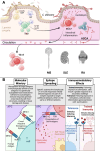Interplay between fungal infections and autoimmunity: mechanisms and therapeutic perspectives
- PMID: 40528008
- PMCID: PMC12254399
- DOI: 10.1038/s44321-025-00262-y
Interplay between fungal infections and autoimmunity: mechanisms and therapeutic perspectives
Abstract
Fungal infections and autoimmunity share a complex, bidirectional relationship that significantly impacts patient outcomes. Emerging evidence highlights how fungal pathogens contribute to autoimmune processes by triggering immune dysregulation. Conversely, autoimmunity and its immunomodulatory treatments increase susceptibility to fungal infections. These interactions manifest through altered immune responses, including changes in inflammatory signaling, antigen recognition, and mycobiome composition. The resulting interplay complicates disease management, necessitating careful balancing of antifungal defenses with immune modulation. This review synthesizes current knowledge on the role of fungal infections in the progression of autoimmune conditions and explores how autoimmune diseases predispose individuals to fungal infections. Key insights emphasize the need for integrative treatment approaches, addressing both infection risks and immune system imbalances.
Keywords: Antifungal Therapeutics; Autoimmunity; Fungal Infections; Mycobiome.
© 2025. The Author(s).
Conflict of interest statement
Disclosure and competing interests statement. MLS currently receives funds from Ono Pharmaceuticals, Co. Ltd. to unrelated topics covered in this review.
Figures



Similar articles
-
Fungi and cancer: unveiling the complex role of fungal infections in tumor biology and therapeutic resistance.Front Cell Infect Microbiol. 2025 Jun 10;15:1596688. doi: 10.3389/fcimb.2025.1596688. eCollection 2025. Front Cell Infect Microbiol. 2025. PMID: 40557321 Free PMC article. Review.
-
Immunomodulatory effects of calorie restriction and its mimetics: A new potential therapeutic approach for autoimmune diseases.Pharmacol Rev. 2025 Jul;77(4):100063. doi: 10.1016/j.pharmr.2025.100063. Epub 2025 Apr 29. Pharmacol Rev. 2025. PMID: 40449126 Review.
-
Lactate and lactylation: emerging roles in autoimmune diseases and metabolic reprogramming.Front Immunol. 2025 Jun 27;16:1589853. doi: 10.3389/fimmu.2025.1589853. eCollection 2025. Front Immunol. 2025. PMID: 40655145 Free PMC article. Review.
-
Antifungal agents for preventing fungal infections in non-neutropenic critically ill patients.Cochrane Database Syst Rev. 2016 Jan 16;2016(1):CD004920. doi: 10.1002/14651858.CD004920.pub3. Cochrane Database Syst Rev. 2016. PMID: 26772902 Free PMC article.
-
Accreditation through the eyes of nurse managers: an infinite staircase or a phenomenon that evaporates like water.J Health Organ Manag. 2025 Jun 30. doi: 10.1108/JHOM-01-2025-0029. Online ahead of print. J Health Organ Manag. 2025. PMID: 40574247
References
-
- Alonso R, Fernández-Fernández AM, Pisa D, Carrasco L (2018) Multiple sclerosis and mixed microbial infections. Direct identification of fungi and bacteria in nervous tissue. Neurobiol Dis 117:42–61 - PubMed
-
- Bandera A, Trabattoni D, Ferrario G, Cesari M, Franzetti F, Clerici M, Gori A (2008) Interferon-gamma and granulocyte-macrophage colony stimulating factor therapy in three patients with pulmonary aspergillosis. Infection 36:368–373 - PubMed
-
- Bekkering S, Dominguez-Andres J, Joosten LAB, Riksen NP, Netea MG (2021) Trained immunity: reprogramming innate immunity in health and disease. Annu Rev Immunol 39:667–693 - PubMed
-
- Bellocchio S, Gaziano R, Bozza S, Rossi G, Montagnoli C, Perruccio K, Calvitti M, Pitzurra L, Romani L (2005) Liposomal amphotericin B activates antifungal resistance with reduced toxicity by diverting Toll-like receptor signalling from TLR-2 to TLR-4. J Antimicrob Chemother 55:214–222 - PubMed
Publication types
MeSH terms
Grants and funding
- R01-AI160737/HHS | NIH | National Institute of Allergy and Infectious Diseases (NIAID)
- R01 NS120417/NS/NINDS NIH HHS/United States
- R01-NS120417/HHS | NIH | National Institute of Neurological Disorders and Stroke (NINDS)
- R01 AI160737/AI/NIAID NIH HHS/United States
- T32 AI052077/AI/NIAID NIH HHS/United States
LinkOut - more resources
Full Text Sources
Medical

